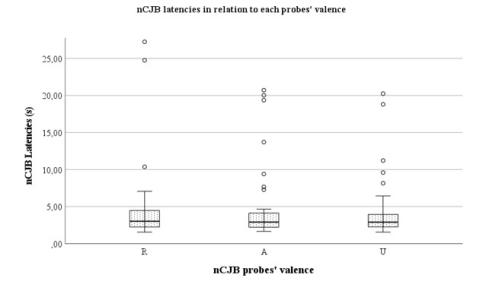Results
The dogs took on average 18 trials to reach learning criterion (Min = 6; Max = 59; S.E. ± 0.714) with on average 30-40 minutes to complete the training and testing phase for each dog during the tCJB test and on average 10-15 mins during the nCJB test.
tCJB

- The latency was the fastest for the rewarded location, slowest for the unrewarded location and the ambiguous location withing both locations' latencies (X²(2) = 143.81; P < 0.001)
- GLM model 1 showed the bowl location did influence the latencies (X²(2) = 300.65; P < 0.001).
- None of the personality traits had an effect on the latencies
nCJB

- No difference in latency was detected between the 3 probes
- The valence did not incluence the latency but the personality trait Excitability did (X²(2) = 25.58; P < 0.001)
Behaviours
Only a few behaviours did influence the lateny to approach the valence in the nCJB:
- The amplitude side of approach
- The weight distribution
- Pulling the bowl
- The speed to approach
- Vocalization
tCJB & nCJb
The tCJB Cognitive Bias Score (Min = -0.03; Max = 1.61; Mean = 0.49; S.E. ± 0.11) and the nCJB CBS (Min = -3.00; Max = 37.85; Mean = 2.93; S.E. ± 2.00) were not correlated when testing for a possible link between the tCJB and nCJB CBS with a bivariate Spearman test (r = 0.11; P = 0.652).
Responsible for this page:
Director of undergraduate studies Biology
Last updated:
